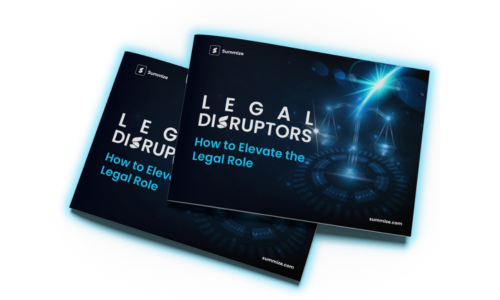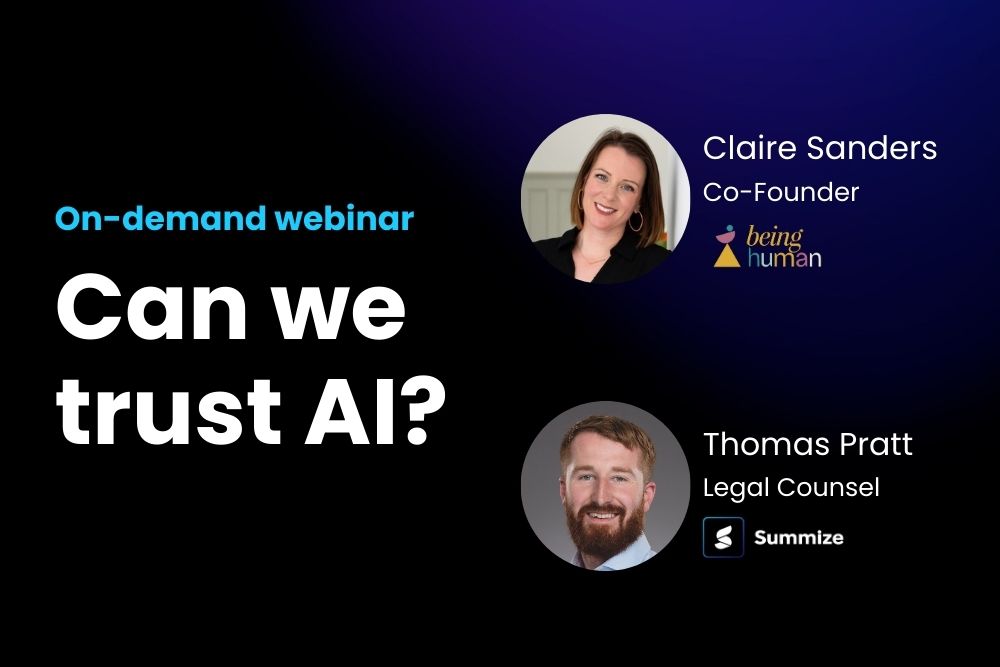On-demand webinar: Is your business tech ready?
This on-demand webinar will uncover what it means to be tech-ready and will provide advice on how to leverage the benefits of contract technology.
December 1, 2022
December 19, 2025
CLM solutions are the hottest legal tech in town… but digitally transforming your entire contract process can seem daunting. After all, 77% of CLM projects result in failed technology implementation.
If you’re asking yourself “where do I start?”, we have the webinar for you! In this exciting session, we’ll uncover what it means to be tech-ready, for the best possible chance of success in Contract Lifecycle Management (CLM) implementation or expansion.
Tom Dunlop (CEO & Founder @ Summize) and Roisin Noonan (COO @ TLB) provide practical advice on how to really leverage the benefits of technology. They’ll cover everything from where to start with process mapping, template remediation, playbook creation and rollout planning – so you can build a plan for internally resourcing your CLM requirements.
Our experts have collated the most frequently asked questions and learnings from hundreds of CLM implementations to pass that knowledge onto you, so you’re in the best possible position to implement (and benefit from) legal technology. Explore the full conversation by watching the webinar recording below, or keep reading for a condensed overview.
Meet the speakers
Tom Dunlop, Co-founder & CEO at Summize: A former General Counsel in high-growth tech companies, Tom founded Summize to solve the everyday challenges in-house legal teams face when managing contracts. What began as a tool to summarize signed contracts has evolved into a full end-to-end CLM platform focused on usability, integration, and meeting users where they already work (Teams, Slack, Word, etc.).
Roisin Noonan, COO at TLB: Roisin leads operations at TLB, a legal optimization company specializing in legal design, operations, and legal transformation. TLB partners with in-house teams to make legal functions more effective, including hands-on support for tech implementations. Roisin also co-founded oneNDA and Claustack, initiatives aimed at standardizing and simplifying legal work.
Why tech readiness matters
One of the biggest themes Roisin spotlighted is that egal tech is not plug-and-play. Unlike everyday tools such as Teams or Slack, CLM impacts multiple departments, requires process alignment, and relies heavily on stakeholder adoption.
Common challenges TLB sees include:
- No clear implementation objectives
- Limited internal resources
- Lack of stakeholder buy-in
- Overly complex templates or processes
- No communications plan
- Unrealistic timelines
- Trying to digitalize before optimizing
Four steps to becoming tech-ready
Roisin outlined clear, practical steps every organization should take before onboarding a CLM:
- Identify your project resources: You don’t need a huge project team, but you do need a dedicated lead and clear internal support. If internal bandwidth is limited, consider external specialists (like TLB) who can streamline the process.
- Optimize your templates: Lengthy, complex templates become even more cumbersome when mapped into a form-based workflow. Clean, simplified templates dramatically improve user experience and adoption.
- Build and update playbooks: Playbooks, which guide users on clause positions, fallback options, and ready-made responses, are essential for speeding up review and enabling consistency. Summize’s Microsoft Word add-in allows users to see their playbook side-by-side as they review, so having these ready early is a major accelerator.
- Create a strong communications plan: Legal tech implementations live and die by communications.
Start early, tailor messaging to each stakeholder group, keep information simple, and meet users where they already work (Slack, Teams, email, workshops, etc.).
How Summize approaches implementation
Within the discussion, Tom shares Summize’s typical 12-week launch framework, designed to create early wins and drive business-wide adoption:
- Define and prioritize use cases
- Train legal teams and business users
- Deliver launch communications, training videos, and support materials
- Run Q&A sessions, gather feedback, and refine
This process emphasizes that implementations shouldn’t try to onboard the entire CLM at once. Instead, onboarding is structured around phased, use-case-led rollouts that give users immediate value.
Real-world examples of CLM in action
- AppLearn, moving beyond legal efficiency: AppLearn used Summize not just for legal review, but to extract key operational terms like SLAs and deadlines. This improved cross-team visibility and strengthened customer relationships by ensuring teams stayed proactive rather than reactive.
- Replacing an underused all-in-one platform: In another rollout, Summize replaced a legacy platform that had failed to gain adoption. With strong upfront communication and user-friendly features, particularly the Teams chatbot, users understood the “why” before they saw the tool. Adoption soared because the system integrated into tools employees already used daily.
Final takeaways
Implementing a CLM isn’t just a software project, it’s a transformation project. The most successful teams:
- Prepare early
- Prioritize realistic, high-value use cases
- Simplify templates and processes
- Invest in communication and training
- Use the right mix of tech and expert support
Whether you're at the stage of exploring vendors or already planning a rollout, the insights shared by Tom and Roisin will help you build a smoother, more successful path to CLM adoption.
Watch the full webinar to see how Summize and TLB help teams become genuinely tech-ready and unlock instant value from a CLM.
If you would like to attend more of our webinars, take a look at our Events for the next few sessions.
Discover even more!
Explore more about contracting and CLM in our ultimate contract guides








